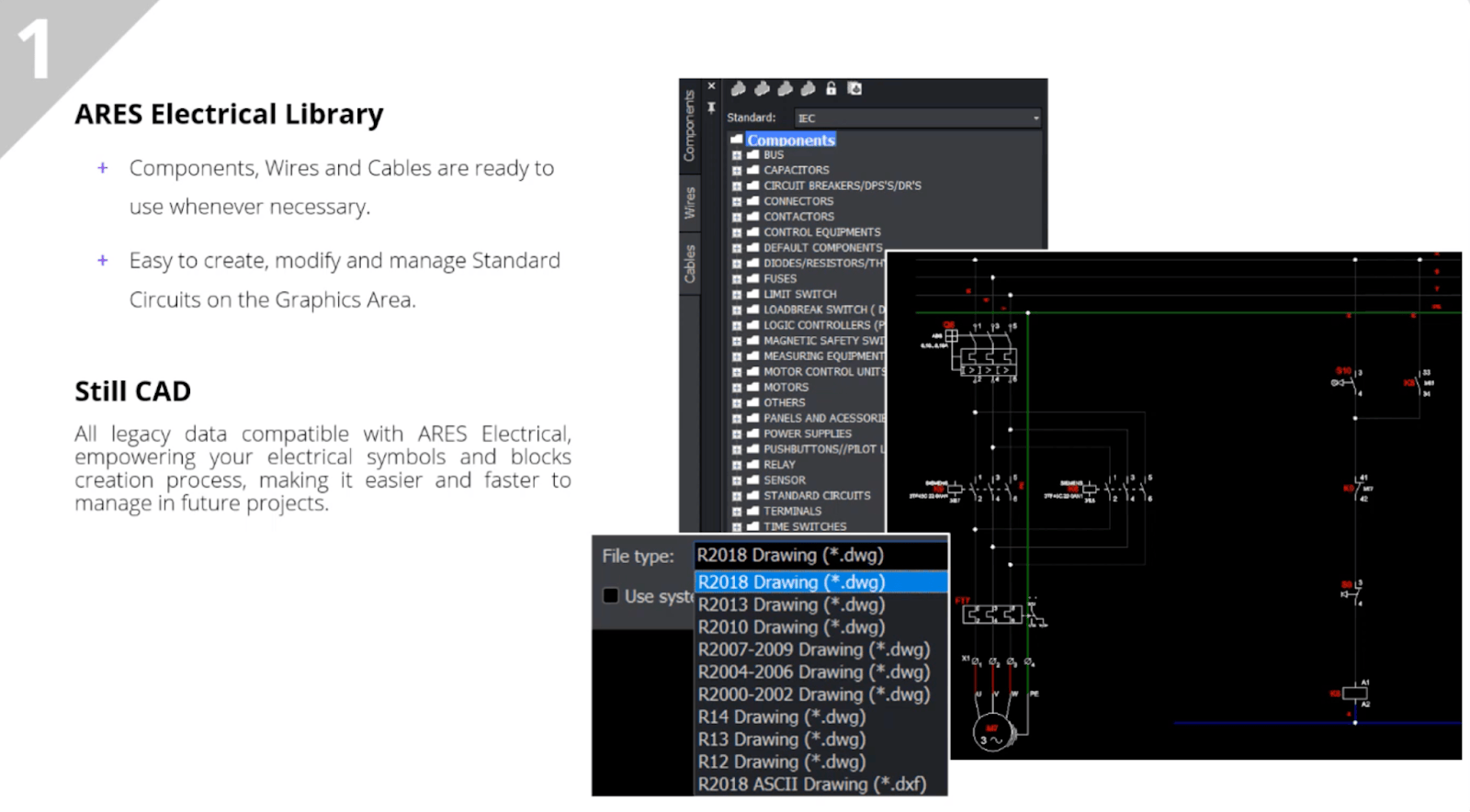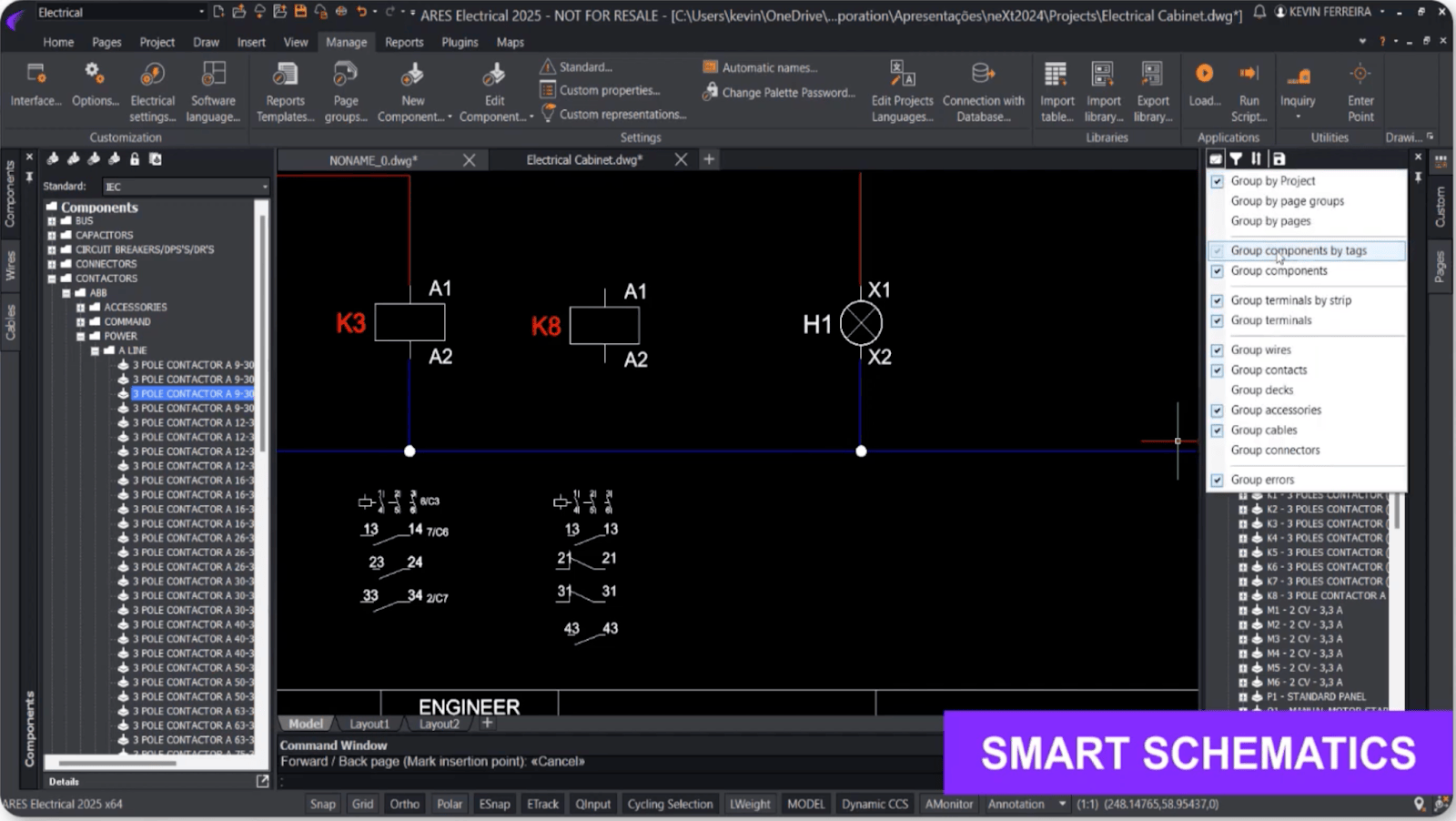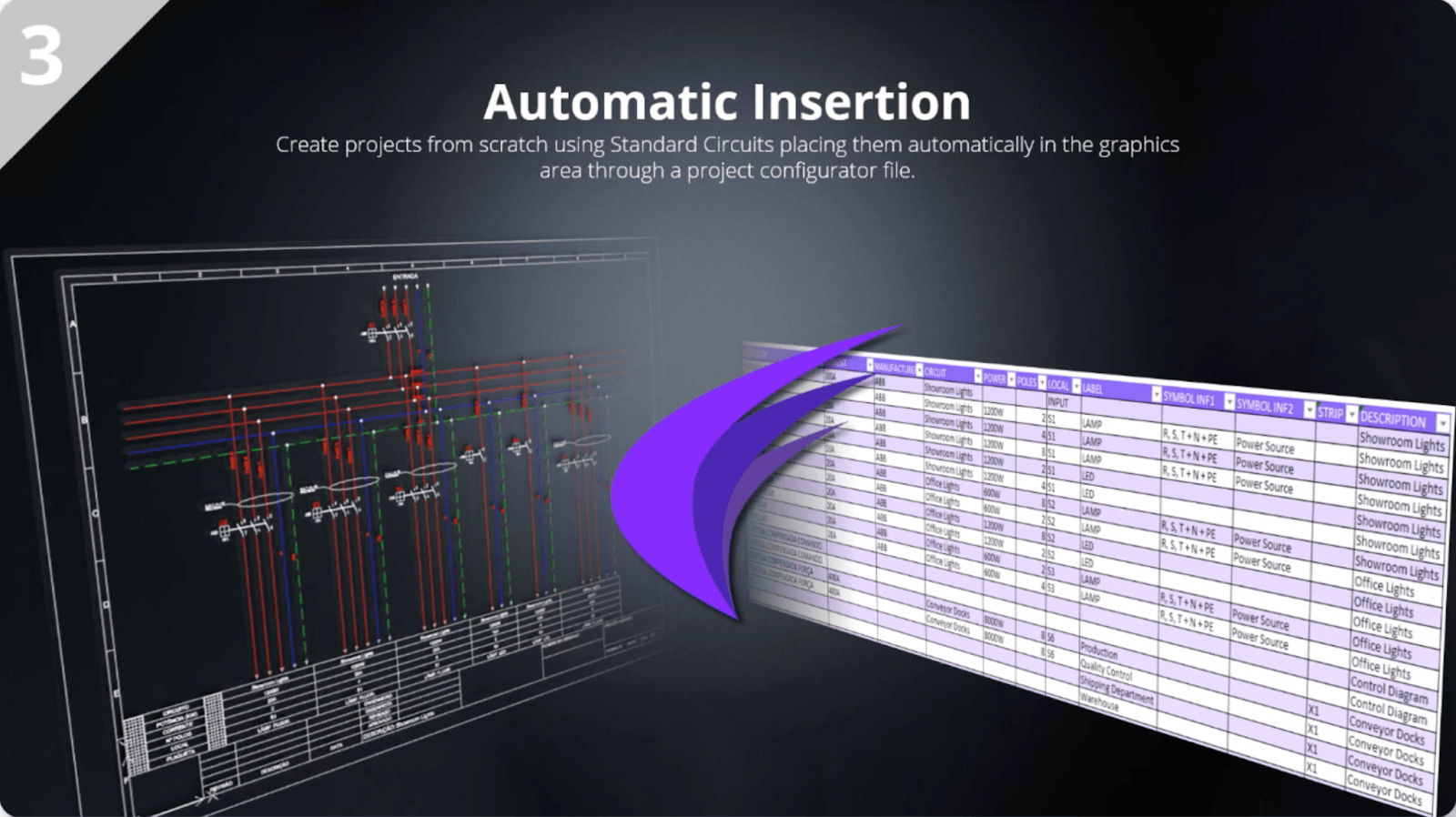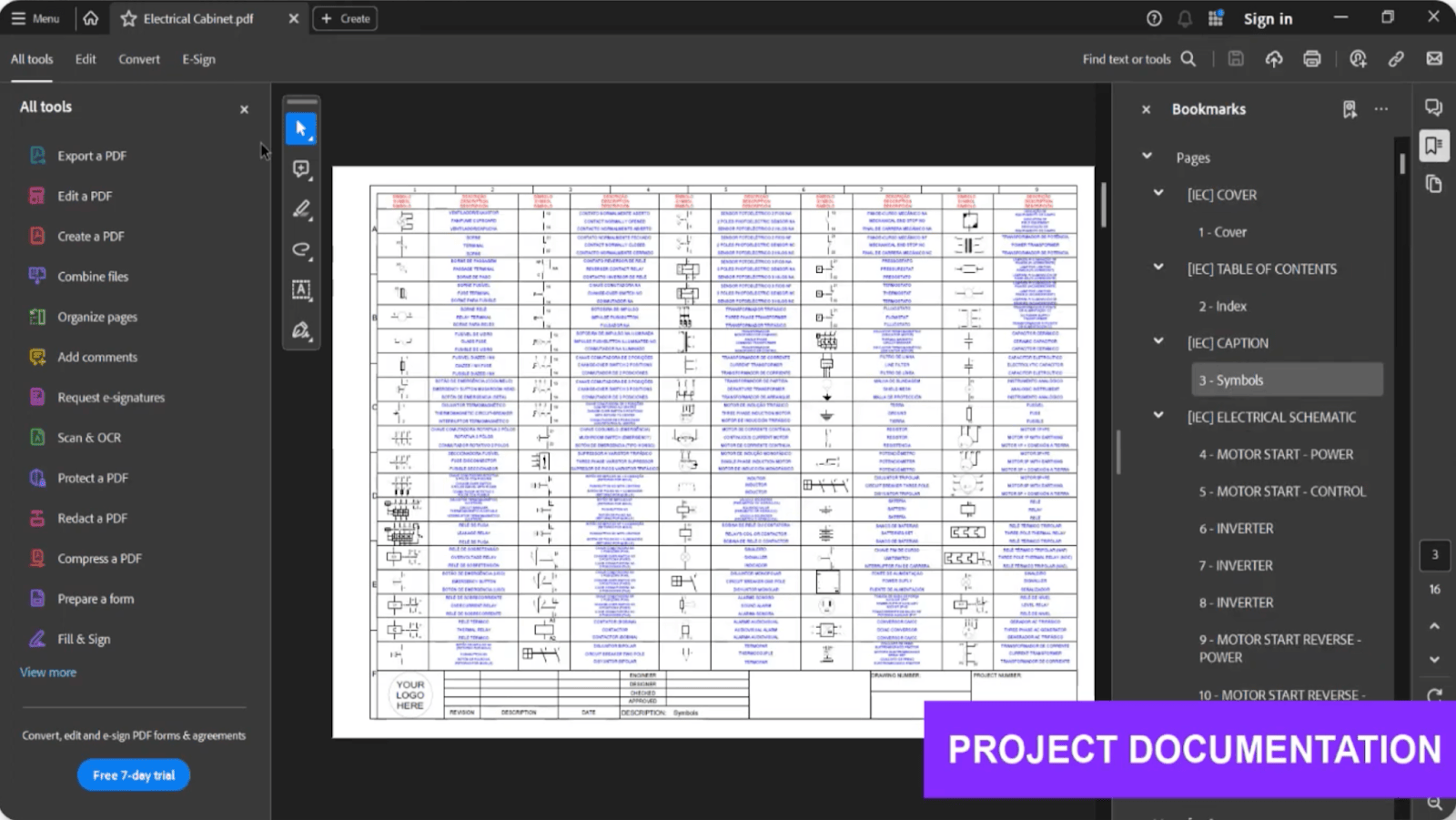Automating Electrical Schematics with 2D CAD Wired for DWG
An overview of ARES Electrical CAD software highlights automatic wire numbering, automatic placement of standard circuits, a pre-populated component library, and more time-saving features.


An overview of ARES Electrical CAD software highlights automatic wire numbering, automatic placement of standard circuits, a pre-populated component library, and more time-saving features.
The 2024 Graebert neXt event featured keynote sessions from a range of industry thought leaders and Graebert product experts, all conveniently presented online. Robert Graebert, Ph.D., the Chief Technical Officer for Graebert, and Kevin Ferreira, Product Specialist Engineer at Graebert, teamed up to provide an overview of ARES Electrical and demonstrate the software’s features for prospective and experienced users alike.
Here, we’ll explore highlights from their keynote presentation. Visit Graebert’s YouTube channel to watch the full ARES Electrical keynote, plus other presentations from the neXt event.
Click to watch the full keynote presentation on Graebert’s YouTube channel.
What Is ARES Electrical?
Even users who are very familiar with ARES Commander, Graebert’s flagship desktop CAD software application, may not know that there is a closely related product specifically tailored for designing electrical enclosures. “ARES Electrical bridges the best of both worlds, combining all essential CAD features provided by ARES Commander with specialized tools for industrial electrical project development,” explained Robert Graebert.
ARES Electrical is primarily used to create comprehensive electrical diagrams. These may include power and control diagrams, PLC (programmable logic controller) drawings, or designs for high- and low-voltage power substations, for example. The software’s capabilities also include automating drawing tasks and generating comprehensive projects, complete with all necessary documentation.
“ARES Electrical is the go-to solution for any company engaged in 2D CAD electrical design. If creating detailed electrical drawings is essential for you and your organization, ARES Electrical is perfectly suited to meet your needs,” Robert Graebert noted.
Easy Integration of New and Legacy Data
Kevin Ferreira pointed out some key aspects of the software that support smoother project development. First of all, because ARES Electrical includes full DWG-based CAD functionality, users can read and modify DWG files in the same way they are used to, and can save them directly in the DWG format.
ARES Electrical libraries are based on DWG CAD blocks. Working with the Component Creation Wizard, users can create new blocks from scratch — or search and apply their stored legacy blocks, adjusting the block shape, component metadata, electrical behaviors, properties, etc. as desired. Working from legacy DWG blocks and data, including component symbols and standards, can yield faster progress on projects.

In addition, Ferreira noted, ARES Electrical comes equipped with an extensive component library stocked with more than 7,000 references to jump-start any project. “This library allows users to efficiently manage components, wires, and cables across power schematics, control diagrams, and mechanical layouts, ensuring adherence to company standards and facilitating project standardization,” he explained. “With the ability to store standard circuits for quick insertion and modification, ARES Electrical streamlines the design processes, enhancing productivity and reducing errors.”
The Secrets of Smart Schematics
The Smart Schematics functionality in ARES Electrical automates routine tasks, improving consistency across the project and reducing errors. Ferreira pointed out some of the benefits of Smart Schematics:
- Cross-referenced blocks are updated in real time, even as components shift within the drawings.
- Project wires can be automatically numbered according to the organization’s predefined business rules, and specific wire names can be locked when necessary.
- Automatic updates to page numbers, component tags, and wire numbers reduce project errors and manual workload, aligning with company- or project-specific standards. “With Smart Schematics, manual updates are a thing of the past,” Ferreira said.

Automation’s Impact on Project Generation
Ferreira also demonstrated how automation can speed up standard project generation. Thanks to the automation features, users can scale projects rapidly and even run multiple projects in parallel, increasing productivity while maintaining the flexibility to edit and modify circuits as needed.
Streamlining standard design processes can reduce time to market, and also free up time for users to focus on more complex, customized designs. Automatic Insertion does just that, by enabling users to automatically place standard circuits in the graphics area through a project configurator file. “With the ARES Electrical Automatic Insertion tool, we can kick-start a project from scratch with all elements, including all sheets information, and sub-circuits automatically placed based on predefined business rules, using a spreadsheet as a project configurator,” Ferreira explained.
Creating Detailed, Sharable Documentation — Automatically
Regardless of the type of project, is always cheaper and more efficient to address changes in the design stage than in the assembly stage. Mechanical layout drawings help users to identify potential problems early, so they can make any necessary adjustments before moving to the next step.
ARES Electrical makes it easy to generate all the necessary documentation, including bills of materials, wire lists, and terminal strip drawings. “Automating the documentation process, we ensure every project detail is meticulously captured and easily shareable, streamlining the assembly stage and reducing costs,” said Ferreira.

Users can create crucial project documentation easily, thanks to the automation features in ARES Electrical.
Trinity Features Foster Cross-Platform Collaboration
The ARES Trinity of CAD software incorporates ARES Kudo and ARES Touch as well as ARES Commander, which is the basis of ARES Electrical. The components of ARES Trinity form an interconnected CAD ecosystem, with robust collaboration tools that enable efficient and synchronized teamwork from any location.
“ARES Trinity excels in fostering collaboration, enabling users to access and modify projects from any device, anywhere, whether through a desktop application, browser, or a mobile device,” explained Robert Graebert. “ARES Trinity ensures that the modifications are synchronized in real time, enhancing teamwork and project flexibility.”

ARES Trinity collaboration features help users coordinate work across desktop, mobile, and online platforms.
Get Your Free Trial of ARES Electrical
To see firsthand how ARES Electrical can benefit your team, start your free trial today. Simply create your free Graebert account and download the software, which is currently available in English, Spanish, and Portuguese, with more languages on the way. Soon you’ll be streamlining project development, automating schematic design, and enhancing collaboration in your organization!

 nikhil
nikhil 





